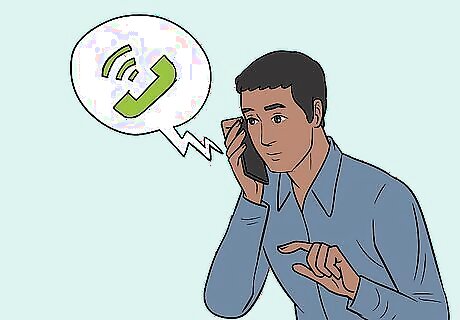
views
Examining Their Profile

Do a reverse-image Google search to see if their pictures are real. Go to the Google home page and click on “images” in the top right corner. Then, click on the camera icon to search by image. From there, you can enter the URL for the picture or upload a copy of the photo. Click search to find any other locations on the Internet where that image appears. If the pictures are real, the image likely won’t appear on other sites, except for the person’s other social media profiles. If other profiles exist, click on them to see if they appear to be the same person or an original account that’s been copied. Stolen photos will likely appear in multiple places, sometimes on professional photography sites. Additionally, you might see that the photos are of someone who has a different name from the person you’re talking to.

Notice if all of their photos are professional. While it’s normal for people to include some professional photos on their page, it’s rare for someone to only have professional photos. This is usually a sign that a catfish is using modeling photos or pictures stolen from a photographer’s website. Professional photos might include headshots, posed photos, or fashion shots. If their profile looks like a magazine, it might not be real.Tip: An social media account that has very few photos that are all professional is likely a catfish.

Check if they have photos with their friends. Most people use social media to talk about what’s going on in their lives. That means they’ll post photos of them hanging out with their friends and going to social events. If you’re talking to someone who never posts photos with other people on their profile, they may be a catfish. If they’re stealing someone’s photos, they may have pictures of them with other people. However, check that these people are in their friends or followers list. If they’re really the person in their photos, you’ll find a connection.Tip: Catfish usually don’t have any tagged photos. If their friends aren’t tagging them, they may not be who they’re saying they are.

Look for dating app matches on social media to see if they’re real. When you meet someone on a dating site, search for their name or image online to see if you can find their other profiles. Compare the information you find online to what they’re telling you through the dating app. This can help you make sure they’re not a catfish. It’s normal for people to hide their identity when they first connect through a dating site. However, they should tell you their real name after the first few exchanges. If they won’t, take a step back because they might be hiding something.

See if their social media account has very few followers. A catfish won’t have many followers on social media since they aren’t who they say they are. They won’t have any real life connections to friend or follow on social media. Look at their list of followers to see how many they have and if their accounts look real. If they have fewer than 100 followers, they may be a catfish. However, it’s possible that they’re just really protective of their privacy, so don’t draw a conclusion based only on this.

Look for holes in their biography or story. A catfish is lying to you, so they’ll probably get their story mixed up sometimes. Listen carefully for inconsistencies in what they’re saying. Additionally, take note if something they say doesn’t quite make sense. For instance, they might tell you that they couldn’t answer your call because they were getting their car fixed, but then later tell you that they don’t have a car. Similarly, they may tell you they work as a registered nurse but then say they never finished college.
Watching for Red Flags

Notice if they send generic or grammatically-incorrect messages. At first, a catfish may send the same messages to different people, trying to get a bite. Similarly, many catfish are from a different country from the person they’re catfishing, so they may not speak your language. Check to see if their messages seem really basic or have a lot of grammatical or spelling errors. For instance, they might only send messages like, “How r u?” “What r u doin?” or “How is ur day?” Their responses to your questions might only be, “Lol,” “yes,” “no,” and “good.” It’s normal for people to occasionally send you a generic message, but there should also be longer responses and follow up questions.

Pay attention if they ask you for money. A person who is genuinely interested in you shouldn’t start asking you for money, especially not right away. However, a catfish will ask for cash as soon as they think you’re willing to send it. If they request money, take a step back and reassess the situation. You may have been hooked by a catfish. The catfish might ask for money for something that will help you. For instance, they might say, “I really want to meet you this weekend, but my car needs repairs. If you send me $100, I’ll get my car fixed and repay you when we meet on Saturday.”

Question them if you catch them in a lie. If you notice an inconsistency in what they’re telling you, don’t let it go! Immediately call them on it and ask them why they made the mistake. Use your best judgement to decide if their response seems reasonable. For example, let’s say the person tells you they’re at work, but then they say they lost their job a month ago. Say, “I thought you said you were at work yesterday? Why are you giving me a different answer?” A reasonable response might be, “I was babysitting yesterday to earn extra cash, so I just said I was working.”

Be cautious if they push a relationship too fast. It’s common for catfish to get too close too soon. They might start saying “I love you” or talking marriage right after you start messaging. This is always a red flag. It might feel really good to be getting this attention, but don’t dive into a relationship until you know who they are. It takes time for a normal relationship to develop. If someone is telling you they love your or that you’re “the one” before they really know you, then they aren’t being genuine.

Take a step back if they ask for revealing photos. While this doesn’t necessarily mean they’re a catfish, asking for revealing photos is always a red flag. Additionally, it’s a step right out of the catfish playbook. Don’t send photos to anyone you don’t know and trust, and slow things down with someone who starts asking too early. If you’re underage, don’t ever take revealing photos because people may misuse them. Additionally, it’s illegal for people to have your photos. If someone is asking you for pics, talk to an adult you trust right away, even if the person told you to keep it secret.
Verifying Their Identity

Ask them to send you a photo doing a specific action. Since a catfish can only send you photos they found online, they won’t be able to send you a photo that you’ve requested. Choose an action that they’ll be able to do but that won’t be easy to find online. A catfish may get mad at you and refuse to keep talking to you, but that just proves they were up to no good. Here are some ideas: Ask them to hold an empty coffee cup over their head like they’re pouring it out. Get them to hold up a sign with your name on it while also giving a thumbs up sign. Request that they put on several hats and then give a salute.Tip: Make sure you pick something that they’re unlikely to find online. For instance, it’s common for people to take photos of them flashing a peace sign, so don’t ask the potential catfish to do that in their photo.

Call them to see if they answer. While some catfish will talk over the phone, it’s common for them to refuse your calls. If you exchange numbers for texting, give them a call to see if they pick up. Then, listen to their voice to make sure it sounds like the age and sex they gave you in your chats. If they don’t answer, ask them to call you back just in case they were really unavailable. Take things slow or stop talking to them if they keep making excuses about why they can’t talk.

Request a video chat to see them in real life. A catfish will never agree to a video chat because they’d be instantly exposed. Instead, they’ll make a lot of excuses about why they can’t do it. Ask the person to prove their identity by doing a video chat. If they won’t, they may be a catfish. Use services like Skype, Facebook Messenger, Facetime, Whatsapp, and Kik. Most of these services will let you do a video chat for free online or via a cell phone. You can even make international calls! Most people have a working camera on at least 1 of their devices, so there’s no excuse.

Ask the person to meet you if they live nearby. If you’re dating or searching for friends in your area, schedule a meeting with the person soon after you start chatting. Invite them to meet you in a public place so that you’re safe. If they refuse to meet up, they might be a catfish. Give the person 2-3 opportunities to meet up with you, and ask about their availability. If they aren’t trying to help you plan a good time, they’re probably catfishing you.Tip: When you’re meeting a person you met online, always tell someone where you're going. Additionally, choose a location that’s well-lit and in public.



















Comments
0 comment